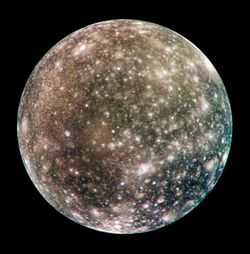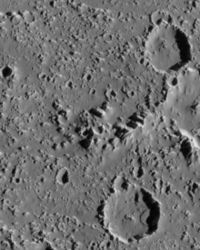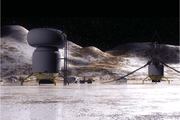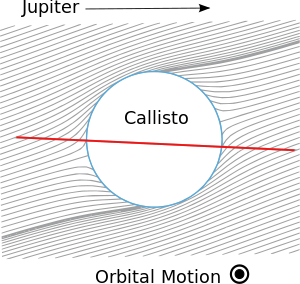كاليستو (قمر)
 View of the heavily cratered terrain of Callisto's anti-Jovian hemisphere obtained in 2001 by NASA's گاليليو spacecraft. The large impact structure آسگارد is on the limb at upper right. The prominent rayed crater below and just right of center is بران. | |||||||||
| الاكتشاف | |||||||||
|---|---|---|---|---|---|---|---|---|---|
| اكتشفه | گاليليو گاليلـِيْ | ||||||||
| تاريخ الاكتشاف | 7 يناير 1610[1] | ||||||||
| التسميات | |||||||||
| Jupiter IV | |||||||||
| الصفات | Callistoan, Callistonian | ||||||||
| السمات المدارية | |||||||||
| Periapsis | 1 869 000 km[b] | ||||||||
| Apoapsis | 1 897 000 km[a] | ||||||||
| 1 882 700 كم[2] | |||||||||
| Eccentricity | 0.007 4[2] | ||||||||
| 16.689 018 4 d[2] | |||||||||
Average orbital speed | 8.204 كم/ث | ||||||||
| Inclination | 0.192° (على مستويات لاپلاس المحلية)[2] | ||||||||
| Satellite of | المشتري | ||||||||
| السمات الطبيعية | |||||||||
نصف القطر المتوسط | 2410.3 ± 1.5 km (0.378 Earths)[3] | ||||||||
Mean radius | 2410.3 ± 1.5 km (0.378 Earths)[3] | ||||||||
| 7.30 × 107 km2 (0.143 Earths)[c] | |||||||||
| Volume | 5.9 × 1010 km3 (0.0541 Earths)[d] | ||||||||
| Mass | 1.075 938 ± 0.000 137 × 1023 kg (0.018 Earths)[3] | ||||||||
Mean density | 1.834 4 ± 0.003 4 g/cm3[3] | ||||||||
| 1.235 m/s2 (0.126 g)[e] | |||||||||
| 2.440 km/s[f] | |||||||||
| متزامن[3] | |||||||||
| zero[3] | |||||||||
| Albedo | 0.22 (هندسي)[4] | ||||||||
| |||||||||
| 5.65 (opposition)[5] | |||||||||
| Atmosphere | |||||||||
Surface pressure | 7.5 pbar[6] | ||||||||
| Composition by volume | ~4 × 108 cm−3 ثاني أكسيد الكربون[6] up to 2 × 1010 cm−3 molecular oxygen(O2)[7] | ||||||||
كاليستو (قمر) (باليونانية: Καλλιστώ؛ إنگليزية: Callisto) هو أحد أقمار كوكب المشتري، اكتشفه جاليليو جاليلي سنة 1610، هو ثالث أكبر قمر طبيعي في النظام الشمسي و الثاني في نظام المشتري بعد گانيميد. لكاليستو نحو 99 ٪ من قطر كوكب عطارد، ولكن فقط ثلث من كتلته.
هذا القمر يتكون من أجزاء متساوية تقريبا من الصخور والجليد ، بمتوسط كثافة تصل حوالي 1.83 g/cm3. مكوناته المكتشفة بواسطة البصمة الطيفية ، تشمل الجليد ، وثاني أكسيد الكربون ، السيليكات ، والمواد العضوية. كما كشف المسبار جاليليو أن كاليستو يحتوي على نواة، وتتكون أساسا من سيليكات ، وكذلك كشف عن إمكانية وجود محيط من المياه السائلة الداخلية في أعماق تتجاوز 100 كم.
اكتشاف وتسمية
في عام 1573 كان الفلكي الألماني سيمون ماريوس أحد أول المستخدمين للتلسكوب وأول من نشر شيئاً مطبوعاً عن مجرة المرأة المسلسلة (1612). وقد درس وسمّى أكبر أربع أقمار لجوبيتر كما كانوا معروفين آنذاك: ايو، اوروپا، گانيميد وكاليستو (1609) على أسماء شخصيات أسطورية مرتبطة غرامياً بجوپيتر. وبالرغم من أنه قد يكون قد قام باكتشافه مستقلاً عن گاليليو، فعندما أعلن ماريوس أنه اكتشف تلك الأقمار لجوپيتر (1609)، في خلاف حول من أول من اكتشفهم، فقد نسب باقي الفلكيين الاكتشاف لگاليليو. إلا أن ماريوس كان أول من أعد جداول للحركات الدورية المتوسطة لتلك الأقمار. كما رصد أيضاً بقع شمسية في 1611.(ت. 1624)
المدار والتناوب

الخصائص الفيزيائية
التركيب

البنية الداخلية
ملامح السطح


الغلاف الجوي والغلاف الأيوني
المنشأ والتطور
احتمال وجود حياة في المحيطات
استكشاف
الاستعمار المحتمل

انظر أيضاً
- Jupiter's moons in fiction
- List of craters on Callisto
- List of geological features on Callisto
- أقمار المشتري
- Valhalla (crater)
هوامش
- ^ Apoapsis is derived from the semimajor axis (a) and eccentricity (e): .
- ^ Periapsis is derived from the semimajor axis (a) and eccentricity (e): .
- ^ Surface area derived from the radius (r): .
- ^ Volume derived from the radius (r): .
- ^ Surface gravity derived from the mass (m), the gravitational constant (G) and the radius (r): .
- ^ Escape velocity derived from the mass (m), the gravitational constant (G) and the radius (r): .
- ^ The leading hemisphere is the hemisphere facing the direction of the orbital motion; the trailing hemisphere faces the reverse direction.
- ^ The dimensionless moment of inertia referred to is I/(mr2), where I is the moment of inertia, m the mass, and r the maximal radius. It is 0.4 for a homogenous spherical body, but less than 0.4 if density increases with depth.
- ^ In the case of icy satellites, palimpsests are defined as bright circular surface features, probably old impact craters; see Greeley et al. 2000.[10]
- ^ To embay means to shut in, or shelter, as in a bay.
المصادر
- ^ خطأ استشهاد: وسم
<ref>غير صحيح؛ لا نص تم توفيره للمراجع المسماةGalilei - ^ أ ب ت ث خطأ استشهاد: وسم
<ref>غير صحيح؛ لا نص تم توفيره للمراجع المسماةorbit - ^ أ ب ت ث ج خطأ استشهاد: وسم
<ref>غير صحيح؛ لا نص تم توفيره للمراجع المسماةAnderson 2001 - ^ أ ب خطأ استشهاد: وسم
<ref>غير صحيح؛ لا نص تم توفيره للمراجع المسماةMoore2004 - ^ "Classic Satellites of the Solar System". Observatorio ARVAL. Retrieved 2007-07-13.
- ^ أ ب خطأ استشهاد: وسم
<ref>غير صحيح؛ لا نص تم توفيره للمراجع المسماةCarlson 1999 - ^ خطأ استشهاد: وسم
<ref>غير صحيح؛ لا نص تم توفيره للمراجع المسماةLiang 2005 - ^ Clark, R. N. (1981-04-10). "Water frost and ice: the near-infrared spectral reflectance 0.65–2.5 μm". Journal of Geophysical Research. 86 (B4): 3087–3096. Bibcode:1981JGR....86.3087C. doi:10.1029/JB086iB04p03087. Retrieved 2010-03-03.
- ^ خطأ استشهاد: وسم
<ref>غير صحيح؛ لا نص تم توفيره للمراجع المسماةCallistoBase - ^ خطأ استشهاد: وسم
<ref>غير صحيح؛ لا نص تم توفيره للمراجع المسماةGreeley 2000
وصلات خارجية
- Callisto Profile at NASA's Solar System Exploration site
- Callisto page at The
NineEight Planets - Callisto page at Views of the Solar System
- Callisto Crater Database from the Lunar and Planetary Institute
- Images of Callisto at JPL's Planetary Photojournal
- Movie of Callisto's rotation from the National Oceanic and Atmospheric Administration
- Callisto map with feature names from Planetary Photojournal
- Callisto nomenclature and Callisto map with feature names from the USGS planetary nomenclature page
- Paul Schenk's 3D images and flyover videos of Callisto and other outer solar system satellites
- Human Outer Planet Exploration (2003) - NASA (with Callisto probes and manned mission concepts)













